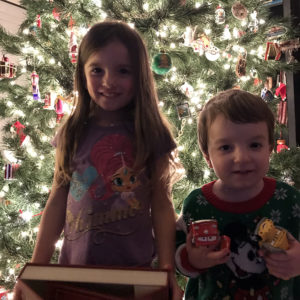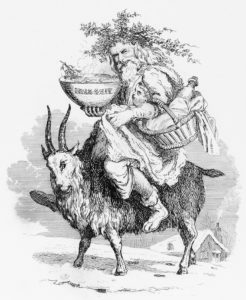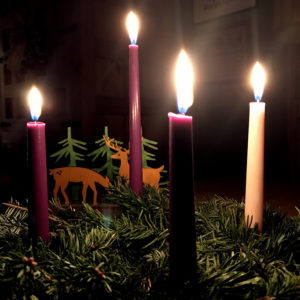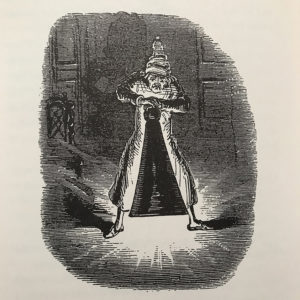And so you have hopefully gathered your chestnuts, your wine and mulling spices, your music… all these good things to take you through the Christmas season. During the day on Wednesday, Seth and I wrote the cards we made and sent them off; our Yuletide greetings never arrive before Christmas (at least not yet) but they do arrive before Twelfth Night. If you’d like one, too, Seth and I would be happy to send you one if you send one our way. You’ll find our mailing address on the Contact Us page of our website. Later in the night, we had our St. Stephen’s Day soup and that was pretty wonderful, a simple and delicious tortellini and chicken soup, which is just what we needed after the feasting of Christmas Eve and Christmas Day. We served it up with shaved parmesan and prosecco and ate it by the candlelight gleam of the four red candles that have taken the place of the rose candle and the three purple candles in the ring that was our Advent wreath, while the blustery wind blew through the open windows in the dark Lake Worth night. As it drew to a close, we roasted chestnuts and made mulled wine and with it, we watched the film version of A Child’s Christmas in Wales. It was, all in all, a pretty wonderful First Day of Christmas.
As promised, here is information you can use for the remaining Days of Christmas that run the course of 2018. With six days of Christmas in the old year and six in the new, Christmastide is a season that stands outside ordinary time, and so we encourage you to keep these days and keep them well.
SECOND DAY OF CHRISTMAS
December 27
St. John’s Day
On St. John’s Day we remember St. John the Evangelist, one of the Twelve Apostles and the only one who did not die a martyr’s death for his beliefs. Attempts on his life were made, though. The most famous attempt was poisoning through wine, but St. John drank the poisoned wine and still it had no effect on him. And so it is customary on this Second Day of Christmas to give gifts of wine, and it is customary to bless our wine. Wine has long been brought to churches on this day, especially in Germany and in Austria, for a blessing by the priest and this blessed St. John’s wine is thought to have healing properties and to taste better than other wines. Some even hold that wine that is not blessed but is stored nearby to blessed St. John’s wine improves in flavor just by being near it. It’s a fine night to enjoy mulled wine and roasted chestnuts.
THIRD DAY of CHRISTMAS
December 28
Holy Innocents’ Day, Childremas
Today we remember the poor children slaughtered by order of King Herod, the insecure leader of Judea who felt threatened upon hearing the news of the saviour’s birth. As such, it is traditionally thought of as the most unlucky day of the year. A more positive approach to the day is to honor children and the children we once were: to reconnect with a time when we were more willing to suspend disbelief, more willing to be fully immersed in things, as children are wont to be. The child you were has certainly informed the adult you’ve become, so there is a thread that resonates across the years. This, we feel, is something worth nurturing. In Spain and Latin America, the Third Day of Christmas is a day for practical jokes, the victims of which being called inocentes, although sometimes it is the prankster that gets that name in a plea for forgiveness. No matter how you spend the day, the theme, it seems, is universal: celebrating and honoring children.
FOURTH DAY of CHRISTMAS
December 29
The Feast of Fools
On this Fourth Day of Christmas, the normal order of things is ceremoniously reversed. It is the Feast of Fools. You might put the children in charge of things. Let them decide what the day’s activities are, let them decide what’s for dinner. Allow yourself to be a little foolish for the day. There’s no harm in that. The Feast of Fools traditions descend directly from the Roman midwinter festival of Saturnalia that inform most of our Christmas traditions. They come out of chaos and entropy: the chaos of the old year dying, unraveling at the seams. A new year is about to be born. As the year goes, so have gone other things through this Yuletide: the sun must die at the solstice to rise again, the son born at Christmas must die to rise again at Easter. The story is an ancient one, told over and over again, in many guises. The story never grows old, and it is the story even of our Convivio Book of Days: it is the wheel of the year, turning always, renewing always.
FIFTH DAY of CHRISTMAS
December 30
Bring in the Boar
On this Fifth Day of Christmas, tradition for an old English Christmas would have us focus on feasting. In particular, we would “bring in the boar.” It is a fine day to sing the old carol known as the “Boar’s Head Carol.”
SIXTH DAY of CHRISTMAS
December 31
New Year’s Eve, Hogmanay, First Footing
It’s the close of the old year, the welcoming of the new. It is a time of complete chaos, when you really think about it, and the symbolism of the New Year is potent magic. New Year’s Eve, which comes tonight, is perhaps the most common night of the year for symbolic foods and rituals. Visit the grocery stores here in Lake Worth and the first thing you’ll see upon entering are black eyed peas and fresh collard greens, and not too far from them, champagne and grapes. Champagne at midnight on New Year’s Eve has become rather universal. The peas and greens are traditional New Year foods here in the South. As for the grapes, well, one old Italian tradition in my family is to eat twelve grapes at midnight, which we rarely do. And on my dad’s side, Grandma Cutrone used to make sure everyone had a spoonful of lentils at the stroke of midnight. In fact, the humble earthy lentil, cooked in various savory dishes, is very big throughout Italy for Capo d’Anno, the New Year. Lentils symbolize riches (think of each lentil as a coin, and you’d have quite a stash in each bowl). “Out with the old” is also very big in Italy for New Year’s Eve, and Italians traditionally make a clean sweep of things at midnight, opening the windows and tossing old useless possessions out onto the streets, no matter from what height (and with great gusto, no less). It can be a dangerous night for a walk about! The act is rich in symbolism, though: this is a night to shed what is unwanted, to dispel bad energy, to clear the way for good things to come.
The only tradition that seems to be a requirement for our family are the zeppole. These are different from the zeppole we buy for St. Joseph’s Day in March; New Year’s Eve zeppole are kind of a fried doughnut––a yeast dough, much like pizza dough, but enriched with eggs. Mom will make the dough and let it raise and sometimes it will bubble up over the sides of the bowl it’s proofing in and then she’ll spoon the dough into hot oil, stretching the dough as it slides into the fat. The result is a light, fried treat that comes in all sorts of shapes that remind you of all sorts of things as you eat them, whether they be drizzled in honey or dusted in powdered sugar or cinnamon sugar. They are so delicious. My dad loved them much more than he liked lentils.
Hogmanay and First Footing refer to the New Year’s traditions of Scotland, where the new year celebration is the biggest part of the Yuletide season. The celebration there is known as Hogmanay, which is believed to to be derived from the French au gui menez, “lead to the mistletoe,” and this suggests a very ancient and pre-Christian derivation of most Hogmanay traditions, for it leads directly back to the Celtic druids and the mistletoe that was sacred to their ceremonies. First Footing is an aspect of Hogmanay that feels particularly like a magic spell: The first person to step across the threshold of the front doorway after midnight is this First Footer, and it is hoped that this person would be a red- or dark-haired man carrying whisky or mistletoe or, in some cases, bread, salt and coal. In this case he would kiss all the women and shake the hands of all the men before placing the coal on the fire and the bread and salt on the table and then he’d kiss all the women and shake hands with all the men once more on his way out.
And so fast away the old year passes. When next you hear from me, we will be amongst the six days of Christmas that fall in the new year. Until then: cheers and wassail, huzzah and good will to all. Merry Christmas.
Those two kids are our grandniece and grandnephew. They both were pretty excited to open presents, but patient all the same, considering we didn’t get around to opening presents until Christmas Night.



